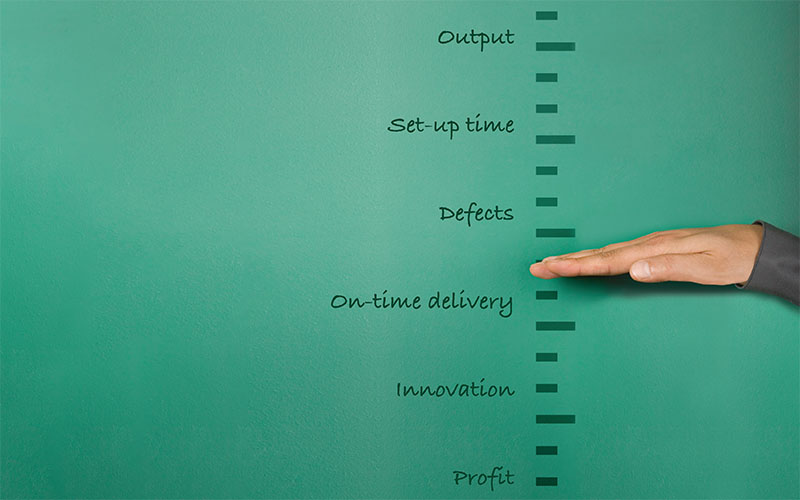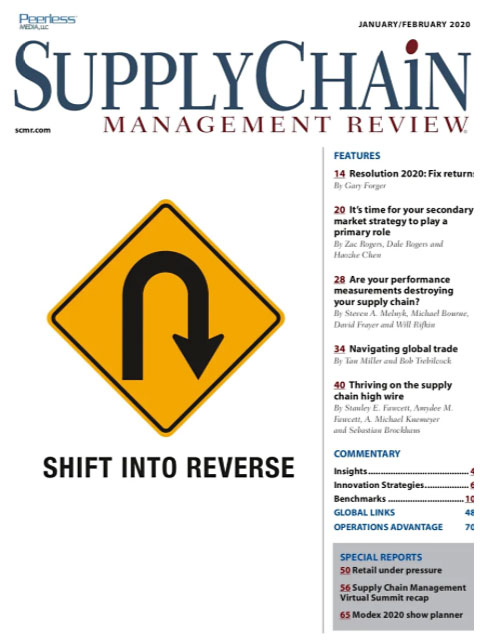Sorry, but your login has failed. Please recheck your login information and resubmit. If your subscription has expired, renew here.
January-February 2020
If the holidays at your household were like most, the gifts were chosen and wrapped with care, and then half were returned in the week after Christmas. Maybe more than half. After all, who among us hasn’t bought four shirts in a variety of sizes and colors with the intent of keeping one and returning three. And why not: Retailers and e-tailers alike have made returns seamless, easy and cheap. At least for the shopper. For the supply chains of the retailer, manufacturer or brand owner, returns are a once-neglected area that is growing into a major focus of supply chain managers who don’t want to see their organizations lose their shirt taking… Browse this issue archive.Need Help? Contact customer service 847-559-7581 More options
Editors Note: This is the second of a two-part article on performance measurement, and continuation of our series on the future of the strategic supply chain by Steven A. Melnyk. Part 1 appeared in the November 2019 issue of Supply Chain Management Review.
The business environment is changing. The rise of new technologies such as the Internet of Things, 3D printing and RFID, the use of Big Data and a change in customer expectations means that issues such as responsiveness, innovation and sustainability are determining the way that companies manage their businesses and operate their supply chains.
While cost will always be important, today’s supply chain is changing from one that is driven y price and decoupled from the business strategy to a value-driven supply chain that is tightly coupled to the business strategy. As the supply chain morphs, so too will performance measurement in order to be more consistent with this environment. What follows are nine guidelines that we believe are essential to the strategic supply chain.
1.) Performance measures must become the vehicle for communicating the voice of the customer and the firm’s value proposition.
This is perhaps the most important change, and the one that will consume most of this article. In “The Customer-Centric Supply Chain,” an article from the July 2017 issue of SCMR, the performance measure links strategy to execution by communicating what the customer wants and what the value proposition promises. To the people involved in the execution of the process, this helps to answer the questions of what the customer wants and what have we promised in meaningful ways. It identifies the shared vision and the priorities of action. As the focus of the supply chain shifts away from cost, we expect the number of measures focused on responsiveness and quality to increase while the number of measures dealing with cost to decrease.

This complete article is available to subscribers only.
Log in now for full access or start your PLUS+ subscription for instant access.
SC
MR
Sorry, but your login has failed. Please recheck your login information and resubmit. If your subscription has expired, renew here.
January-February 2020
If the holidays at your household were like most, the gifts were chosen and wrapped with care, and then half were returned in the week after Christmas. Maybe more than half. After all, who among us hasn’t bought… Browse this issue archive. Access your online digital edition. Download a PDF file of the January-February 2020 issue.Editors Note: This is the second of a two-part article on performance measurement, and continuation of our series on the future of the strategic supply chain by Steven A. Melnyk. Part 1 appeared in the November 2019 issue of Supply Chain Management Review.
The business environment is changing. The rise of new technologies such as the Internet of Things, 3D printing and RFID, the use of Big Data and a change in customer expectations means that issues such as responsiveness, innovation and sustainability are determining the way that companies manage their businesses and operate their supply chains.
While cost will always be important, today's supply chain is changing from one that is driven y price and decoupled from the business strategy to a value-driven supply chain that is tightly coupled to the business strategy. As the supply chain morphs, so too will performance measurement in order to be more consistent with this environment. What follows are nine guidelines that we believe are essential to the strategic supply chain.
1.) Performance measures must become the vehicle for communicating the voice of the customer and the firm's value proposition.
This is perhaps the most important change, and the one that will consume most of this article. In “The Customer-Centric Supply Chain,” an article from the July 2017 issue of SCMR, the performance measure links strategy to execution by communicating what the customer wants and what the value proposition promises. To the people involved in the execution of the process, this helps to answer the questions of what the customer wants and what have we promised in meaningful ways. It identifies the shared vision and the priorities of action. As the focus of the supply chain shifts away from cost, we expect the number of measures focused on responsiveness and quality to increase while the number of measures dealing with cost to decrease.
SC
MR


Latest Supply Chain News
Latest Podcast

 Explore
Explore
Business Management News
- Strengthening customer fulfillment: Building a strategic stakeholder network
- The hard job of teaching soft skills
- Trump picks former Wisconsin congressman Sean Duffy for DOT secretary
- Made in Mexico, manufactured by China
- Retail sales see gains in October, reports Commerce and NRF
- Balancing green and speed: Home delivery insights from the pandemic era
- More Business Management
Latest Business Management Resources

Subscribe

Supply Chain Management Review delivers the best industry content.

Editors’ Picks





